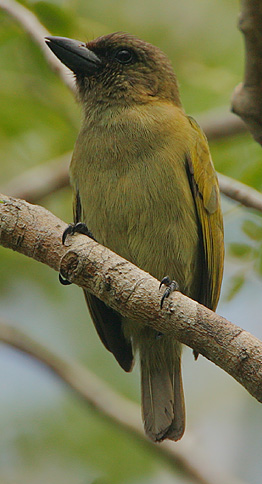
The scarlet tanager is a medium-sized American songbird. Until recently, it was placed in the tanager family (Thraupidae), but it and other members of its genus are now classified as belonging to the cardinal family (Cardinalidae). The species' plumage and vocalizations are similar to other members of the cardinal family, although the Piranga species lacks the thick conical bill that many cardinals possess. The species resides in thick deciduous woodlands and suburbs.

Mountain coatis are two species of procyonid mammals from the genus Nasuella. Unlike the larger coatis from the genus Nasua, mountain coatis only weigh 1.0–1.5 kilograms (2.2–3.3 lb) and are endemic to the north Andean highlands in South America.

The olive ridley sea turtle, also known commonly as the Pacific ridley sea turtle, is a species of turtle in the family Cheloniidae. The species is the second-smallest and most abundant of all sea turtles found in the world. L. olivacea is found in warm and tropical waters, primarily in the Pacific and Indian Oceans, but also in the warm waters of the Atlantic Ocean.

The western mountain coati or western dwarf coati is a small procyonid, found in cloud forest and páramo at altitudes of 1,300–4,250 metres (4,270–13,940 ft) in the Andes of Colombia and Ecuador. A population discovered in the Apurímac–Cuzco region of southern Peru has tentatively been identified as the western mountain coati, but may represent an undescribed taxon.

The olive ibis is a species of ibis native to dense tropical forests in central Africa. Between 65 and 75 cm in length, it is a small ibis with olive plumage displaying an iridescent sheen. Four subspecies are recognized.

The olive sunbird is a species of sunbird found in a large part of Africa south of the Sahel. It prefers forested regions, and is absent from drier, more open regions such as the Horn of Africa and most of south-central and south-western Africa. It is sometimes placed in the genus Nectarinia.

The green barbet is a species of bird in the Lybiidae family. It is found in Kenya, Tanzania, Malawi, Mozambique and South Africa. It occurs in forests from sea level to 1,800 metres (5,900 ft). Its isolated populations are vulnerable to forest clearing.

The brown-tailed mongoose, brown-tailed vontsira, Malagasy brown-tailed mongoose, or salano is a species of mammal in the family Eupleridae. It is endemic to Madagascar. Its natural habitat is moist lowland tropical forest. It is threatened by habitat loss.

Acalolepta is a genus of flat-faced longhorns beetle belonging to the family Cerambycidae, subfamily Lamiinae. Its members are found in the Indomalayan realm.
Acalolepta sikkimensis is a species of beetle in the family Cerambycidae. It was described by Stephan von Breuning in 1935.
Acalolepta magnetica is a species of beetle in the family Cerambycidae. It was described by Francis Polkinghorne Pascoe in 1866, originally under the genus Monochamus. It is known from Micronesia, Moluccas and Indonesia.
Acalolepta permutans is a species of beetle in the family Cerambycidae. It was described by Francis Polkinghorne Pascoe in 1857, originally under the genus Monohammus. It is known from Japan, Vietnam, Taiwan, and China. It feeds on Albizia julibrissin.
Acalolepta montana is a species of beetle in the family Cerambycidae. It was described by Per Olof Christopher Aurivillius in 1916. It is known from Sulawesi.
Acalolepta flocculata is a species of beetle in the family Cerambycidae. It was described by Gressitt in 1935. It is known from Taiwan and China.
Acalolepta antenor is a species of beetle in the family Cerambycidae. It was described by Newman in 1842. The typical form is known from the Philippines, but numerous subspecies are widespread in Indonesia, Moluccas, Micronesia, New Guinea, Australia, Solomon Islands and Samoa.

Acalolepta fraudatrix is a species of beetle in the family Cerambycidae. It was described by Henry Walter Bates in 1873. It is known from Korea, Japan, China, and Russia.
Acalolepta mixta is a species of beetle in the family Cerambycidae. It was described by Frederick William Hope in 1841, originally under the genus Monohammus. It is known from Australia, and was introduced to the Solomon Islands, Indonesia, Singapore and Vietnam. It feeds on Theobroma cacao, Adansonia digitata, Mangifera indica, Excoecaria agallocha, and Moringa oleifera.
Acalolepta rusticatrix is a species of beetle in the family Cerambycidae. It was described by Johan Christian Fabricius in 1801, originally under the genus Lamia. It is known from Myanmar, India, the Philippines, Malaysia, Sumatra, Sri Lanka, Java, Taiwan, Indonesia, Sulawesi, and Vietnam.
Acalolepta sejuncta is a species of beetle in the family Cerambycidae. It was described by Henry Walter Bates in 1873. It is known from Japan.








